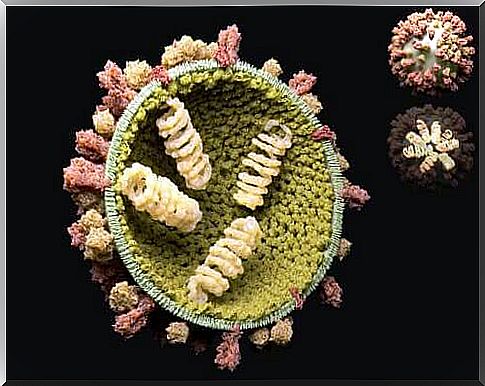The Reproduction Cycle Of Viruses

The virus reproduction cycle is complex and interesting. These particles do not have cells and therefore cannot reproduce autonomously. To do this, they need a host, that is, a living organism. Inside that organism, viruses are capable of replicating, while outside they are subject to destruction.
The reproductive cycles of viruses can be of two types:
- lithic
- Lysogenic
The lytic reproductive cycle occurs when the virus enters the cell and immediately transcribes its genetic material. That is, it attacks the cell quickly and directly.
In the lysogenic cycle, by contrast, viruses insert themselves into the DNA of their host cell. When they do this, it becomes very difficult to detect them and they multiply unnoticed. In other words, they camouflage themselves within the infected structure.
The stages of the reproductive cycle of viruses
Viruses are structures composed only of nucleic acids and some proteins. Therefore, they are very small units. Science does not classify them as living beings, but neither are they dead. Even so, they perform two functions proper to living beings: relating and reproducing.
Viruses contain a genetic molecule that is almost always surrounded by a layer made of proteins and sugars. When they enter a host cell, they go to the nucleus and hijack it. That is, they put it to work for their benefit and then they start to multiply.

Adsorption and penetration phase
The first stage of the virus’s reproductive cycle is adsorption or fixation. It corresponds to the moment when the virus comes into contact with the organism it is going to infect. Usually this happens randomly – like when someone sneezes and someone else is nearby.
What happens next is that the virus recognizes the receptors of the cell where it is going to lodge and, in doing so, adheres to that cell’s membrane. After that, the second phase of the virus’s reproductive cycle begins, which is penetration. This consists of injecting your genetic material into the cell.
The process is similar to what happens with a syringe, but in this case what the virus injects is genetic information. To do this, it needs to break the cell membrane, which happens thanks to the release of an enzyme.
Multiplication and assembly phase
Once the virus penetrates the host cell and kidnaps it, the next phase of the reproduction cycle begins: multiplication. This consists of replicating your genetic material. What the virus seeks is to create the components so that new viral particles are formed.
As there are different types of viruses, there are also different ways to carry out this process. When the multiplication process ends, assembly begins. This consists of taking the different pieces and putting them together in a structure that forms new virus bodies.

release phase
The last phase is the release of new virus bodies, or virions, outside the cell. They search the body until they find a new cell to host them, and then repeat the entire reproductive cycle.
Some types of viruses carry out this release process in a forced manner. In other words, they manage to escape by breaking the cell membrane from which they originated. If viruses are wrapped in lipids, they go through a process called budding. In this case, they take part of the host cell membrane and are covered by it.
As can be seen, in this last phase, viruses break the cell membrane, and this leads to cell death. This process repeats itself over and over again: viruses move through the body killing cells one after another.
The body activates the immune system to fight them and stop them from doing more damage. If it doesn’t work, it is necessary to resort to medicines to win the battle. If these too fail, serious illness and even death will occur.
Why is it important to understand the virus reproduction cycle?
Understanding the reproductive cycle of viruses allows us to think about how to protect ourselves from them. Preventing these particles is important as there aren’t many effective antiviral medications. Viral illnesses can be mild, like a cold, but also serious, like AIDS.
The greater our understanding of their reproductive process, the more likely we are to be able to fight them. Vaccines and medicines for its treatment come from this knowledge, and therein lies its importance.









